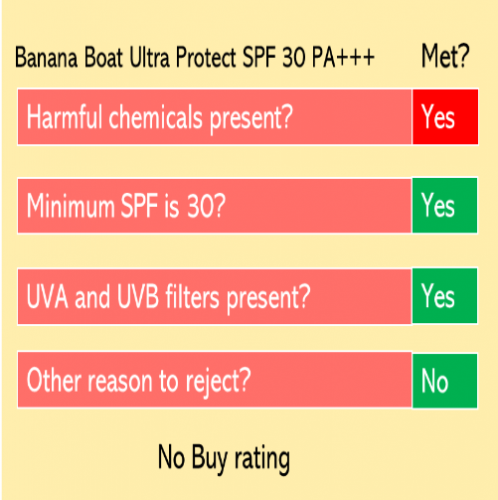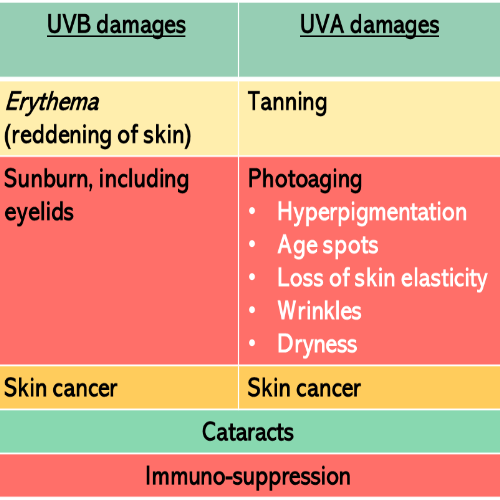
Applying this sunscreen test, the product is a “no Buy.”
1) Harmful chemicals present?
The harmful chemicals present are Benzophenone-3 (or Oxybenzone) and Parabens.
Oxybenzone is a hormonal disruptor and known skin-allergen. It’s probably why Banana Boat doesn’t use it in any of its kid’s products. Also, Oxybenzone is not commonly found in European sunscreens, because this must be disclosed on the label as “Contains Benzophenone-3.”
Parabens are cheap and effective preservatives, that are beloved by manufacturers. They are also estrogen mimickers, (and if you are thinking PCOS then you are not the only one).
You should avoid sunscreens containing Oxybenzone and parabens – there are sufficient alternatives. I am committed to helping you find them.
(If you’d like to read more, please click Chemicals to Avoid – Oxybenzone, Chemicals to Avoid – Parabens)
3) UVA and UVB filters present?
We want the UV filters in sunscreens to protect against over-exposure to both UVB and UVA rays. As an Indian I am concerned with UVA as it causes collagen in our skin to break-down. (Collagen gives skin its structure and resilience).
Photoaging is characterised by hyper-pigmentation, wrinkles, dryness and loss of skin elasticity.
And did I mention that UVA is also responsible for tanning??
3a) Does this product have sufficient UVA filters?
Without doubt. The primary UVA filter is Butyl Methoxydibenzoylmethane (or Avobenzone). Avobenzone, which is a gold standard UVA filter. Avobenzone is also notoriously photounstable: it reduces in efficacy by 50%-90% within 60 minutes of application. To stabilise Avobenzone, Banana Boat have added Oxybenzone and Octocrylene. This works a treat.
In closing
This sunscreen does provide sufficient UVB and UVA protection – the issue is with its harmful chemicals.
That’s it from me. I would love to hear from you and please drop me a line at email@happyskindays.com
See also: Top 5 sunscreen recommendations, Do You Understand The Gibberish On Sunscreen Labels? Myths About Sun-Protection, Why Read a Sunscreen label?
More information follows for the more enthusiastic amongst you.
The Nerd Edit
1) Harmful effects of both UVA and UVB
BOTH UVA and UVB have been implicated in the following:
- Skin cancer
- Photoaging
- Immuno-suppression
- Cataracts
This is important because sunscreens must protect against both UVA and UVB damage. Second sun-damage is cumulative, so you should not wait till your 50 to use sunscreen. Generally speaking we associate the following harmful effects of UVA and UVB:

2) Filters
Sunscreens contain ingredients called ‘UV-filters’ that do the heavy lifting and determine how effective the product will be. Filters are substances protect the skin against certain UVR by absorbing, reflecting or scattering UV radiation.
UVA filters protect mainly against over-exposure to UVA and the damages are summarised above.
UVB filters protect mainly against UVB radiation, namely reddening of the skin (erythema), sunburn and skin-cancer. UVB/UVA filters combine the function of UVA and UVB filters.
The filters present are:
- Octocrylene (a UVB filter) – 2nd ingredient
- Benzophenone-3 (a UVA/UVB filter) – 3rd ingredient
- Butyl Methoxydibenzoylmethane (a UVA filter) – 4th ingredient
Ingredients are listed in descending order of quantity and for sure, this product has sufficient filters.
3) A note on regulation
Indian regulation: Sunscreens are regulated as cosmetics in India and can only use filters that are from a prescribe list of filters that mirrors the EU. India does not have specific sunscreen regulation. This is important because that means there are no minimum standards that manufacturers have to comply with.
4a) Product contains Methylparaben and Propylparaben
Parabens are cheap and effective preservatives that manufacturers love. The problem with parabens is that they are endocrine system disruptors – they act as estrogen mimickers and in a study in the USA, traces of parabens were found in most urine samples of both genders, irrespective of ethnicity. Parabens are easily absorbed into the skin, so if your face products (toner, serum, cream, sun-protection), soap(s), body lotion and parfum all contain parabens, then that’s multiple applications per day. Also, as you constantly reapply sunscreen throughout the day, you are also repeatedly applying parabens.
For the above reason, you should avoid paraben containing products. For more on parabens see Chemicals to Avoid – Parabens.
Sources:
Ceresole, R., Y.K. Han, M.A. Rosasco, et al., “Drug-Excipient Compatibility Studies in Binary Mixtures of Avobenzone,” Journal of Cosmetic Science, vol. 64(5), pp. 317-328, 2013.
Nash, J.F., and P.R. Tanner, “Relevance of UV Filter/Sunscreen Product Photostability to Human Safety,” Photodermatology, Photoimmunology and Photomedicine, vol. 30(2-3), pp. 88-95, 2014.
